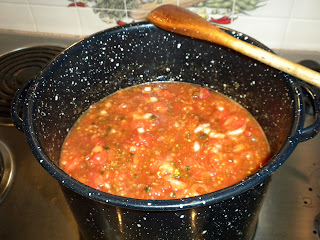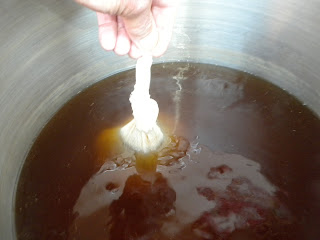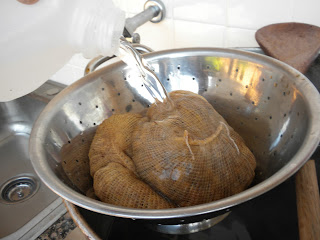I thought I would take you through the process of making my Oktoberfest Marzen beer. This is a smooth, malty amber German beer with a hop bite. I started on September 5, 2012 by buying the ingredients. This beer will be ready to drink on October 1, 2012 at a cost of about $1.00 per bottle.
These are the ingredients from lower left: 1/2 pound Belgian Special Grain, 4 pounds dry amber malt, 1 (3.75 pound) Coopers Lager Malt, 3 ounces Tettnager hops that I grew, 7 grams Coopers dry brewing yeast, and 4 ounces priming sugar. Not shown: about 6 gallons of bottled water.
Above is my outdoor kitchen. In the center you can see the large burner and 30 quart stainless steel kettle that I use to boil the malt and hops.
On September 8, 2012 I started brewing. The first step is to add 2 1/2 gallons of bottled water to the kettle. Place the Belgian special grains in a strainer bag and add it to the water. Bring almost to a boil, turn off the heat and let it sit for 10 minutes.
Next remove the grains and place in a strainer over the kettle and allow to drain.
Pour 1 quart of hot bottled water over the grains to rinse. Discard the spent grains.
Add the dry amber malt and the Cooper's lager malt and stir until they are completely dissolved. Turn on the burner and bring to a boil. Place 2 ounces of the hops in a strainer bag and, once a vigorous boil has been achieved, add the hops to the kettle. Boil for 55 minutes. Place the remaining 1 ounce of hops in another strainer bag, add to the kettle and boil for an additional 5 minutes, then turn off the heat and allow to cool for 20 minutes.
After the 20 minutes of cooling, remove the strainer bags of hops and place in a strainer over the kettle and allow to drain. Then pour the remaining 2 1/2 gallons of very cold bottled water over the hops into the kettle. Discard the hops.
The next step is to cool the kettle ingredients (wort). I use ice water which takes awhile. Cool until the wort is at 80 degrees F.
While the wort is cooling, prepare the yeast by sprinkling the contents of the yeast packet into 1/4 cup of 95 to 105 degree F water. Do not stir.
Transfer the cooled wort to the sterilized fermentor. (I use 1/4 cup of sodium bisulfite, available from your home brew supplier, per gallon of water to sterilize. Make sure to cover all surfaces of the fermentor with the solution then rinse thoroughly with water.) Next add cold bottled water until the wort level is 1 inch above the 5 gallon mark on the fermentor.
Draw off some of the wort into a sterilized testing tube and insert the sterilized hydrometer; then take a hydrometer reading. My starting specific gravity reading is 1.060. To calculate what the finishing specific gravity should be, take the 60 from the starting specific gravity above and divide it by 4 which equals 15. Then divide the 60 by 3 equals 20 meaning that the finishing specific gravity should be between 1.015 to 1.020. This will be about 6 percent alcohol.
Add the yeast to the 80 degree wort and stir to mix.
Place the tight lid on the fermentor and install the air lock that has been filled with water. As the gas from the fermenting is produced, it is released as bubbles through the air lock.As you can see, I have moved the fermentor to my kitchen so I can maintain the fermenting temperature between 65 and 72 degrees F.
Over night the batch starting fermenting vigorously producing "krausen" so I removed the air lock to let the fermenting process continue. The next day the fermenting had calmed down so I was able to clean up the "krausen" and re-install the air lock.
On the 3rd day of fermenting, the fermentation had slowed so I was able to take a hydrometer reading of 1.020 which was in the range of the expected specific gravity (see above). I then transferred the brew to a glass carboy leaving behind the sediment that had settled in the bottom of the fermentor. The air lock was then installed on the carboy and the fermenting continued until I bottled on Sept 16, 2012. I transferred the beer back to a sterile bottling tank (same tank I used for fermenting) and discarded the sediment in the bottom of the carboy.
On bottling day I rinsed out 48 bottles and sterilized them for 2 minutes by immersion in a 25 ppm solution of titratable iodine made by mixing 1 teaspoon of iodophor sanitizer (available from your home brewing supplier) per gallon of water. The bottles were then thoroughly rinsed and allowed to drain. They are now ready for filling.
The next step is to dissolve the priming sugar in 1 cup of beer removed from bottling tank. Heat this mixture on a stove until thoroughly dissolved: then add to the beer in the bottling tank and stir thoroughly to mix. The beer is now ready to bottle.
The sterilized bottles are now being filled to within 1/2 inch of the top by syphoning the beer out of the carboy.
The bottles are then capped using sterilized and rinsed metal bottle caps available from your home brew supplier. I marked the bottles identifying the type of beer and then stored the bottles in a 70 to 80 degree F location to allow the yeast to carbonate the beer for 2 weeks. This batch will be ready to drink on October 1, 2012 but the beer will improve with time peaking in 2 to 3 months. I can't wait!










































